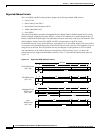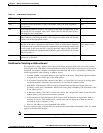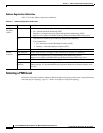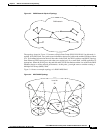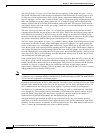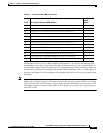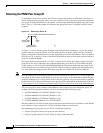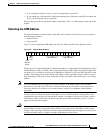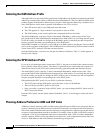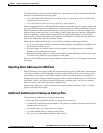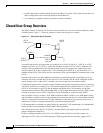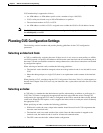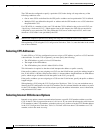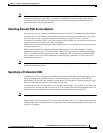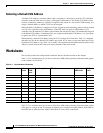
3-12
Cisco PNNI Network Planning Guide for MGX and SES Products, Release 5
Part Number OL-3847-01 Rev. D0, April, 2004
Chapter 3 Address and Closed User Group Planning
Planning Address Configuration Settings
Selecting the ILMI Address Prefix
Although ILMI is not part of the PNNI specification, ILMI addressing should be coordinated with PNNI
addressing to minimize the number of PNNI advertised ATM addresses. The Cisco MGX and SES switch
products support ILMI dynamic addressing on UNI ports. When dynamic addressing is enabled, one or
more ILMI prefixes can be used to generate ATM addresses for CPE as follows:
1. The CPE retrieves the 13-byte ILMI prefix from the switch.
2. The CPE appends its 7 bytes with the 13-byte prefix to form its AESA.
3. The ILMI running on the switch registers the constructed AESA on the switch.
The default ILMI prefix is the first 13-bytes of the default ATM address, which consists of the 7-byte
peer group ID (0x47 0091 8100 0000) plus the unique 6-byte MAC address. If you change the peer group
ID for the switch, you should also change the ILMI address prefix so that the bytes that correspond to
the peer group ID match the corresponding bytes in the ILMI prefix.
When ILMI is enabled on a UNI port, you can add up to 16 address prefixes for that port. The same ILMI
prefix can be assigned to multiple ports. These ILMI prefixes are advertised by PNNI to enable switched
virtual circuit (SVC) routing to CPE that use these prefixes.
Enter the ILMI prefixes you plan to use into the Port Address Worksheet, Table 3-5, which appears at
the end of this chapter.
Selecting the SPVC Address Prefix
If you set up soft permanent virtual connections (SPVCs), the port at each end of the connection must
have a globally unique SPVC address. This address is generated by the switch when the connection is
defined and consists of the SPVC prefix and an internally generated number that identifies the port.
The default SPVC prefix is the first 13-bytes of the default ATM address, which consists of the 7-byte
peer group ID (0x47 0091 8100 0000) plus the unique 6-byte MAC address. If you change the peer group
ID for the switch, you should also change the SPVC address prefix so that the bytes that correspond to
the peer group ID match the corresponding bytes in the SPVC prefix.
When planning the SPVC prefix for your WAN, consider the following:
• The SPVC prefix and the ILMI prefix can be the same, or they can be different.
• There can be just one SPVC prefix for each node.
• Once you create a connection using an SPVC prefix, you cannot change the SPVC prefix until all
SPVCs have been deleted.
Enter the SPVC prefix into the Nodal Address Worksheet, Table 3-4, which appears at the end of this
chapter.
Planning Address Prefixes for AINI and IISP Links
ATM Inter-Network Interface (AINI) and Interim Inter-Switch Protocol (IISP) are two protocols that are
used for connecting private PNNI networks to public PNNI networks or to other private PNNI networks.
These links enable communications between separately managed networks without exposing the internal
structure of each independent network to the other. For example, when an AINI or IISP link is properly
configured, a CPE on one independent network can communicate with a CPE on another independent
network. However, PTSEs are not transmitted across these links, so the independent networks only have
access to ATM addresses that are deliberately shared during configuration.



